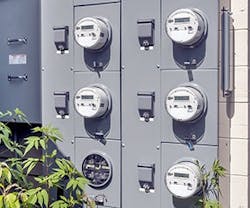How Net Zero Buildings Help Modernize the Grid
The electricity grid was never intended to support a two-way flow of energy – it was designed as a one-way street from power plants to buildings. But with the growth of renewable energy systems and other generation and storage technologies, the grid must be modernized to accommodate two-way energy transactions.
Demand response technologies and “grid-sensitive” design will be vital to developing this transactive framework, according to a new white paper by Alexi Miller and Jim Edelson, ASHRAE associate members and New Buildings Institute (NBI) representatives. The authors focus on net zero energy buildings but note that even properties that are not operating at the net zero level “must be explicitly designed with both active and passive efficiency and demand response features to optimize the interactions between buildings and the utility grid.”
Paths between Buildings and the Grid
Buildings interact with the grid in three key ways, according to Miller, a Senior Project Manager for NBI, and Edelson, the Director of Codes and Policy:
1) Conventional buildings: This category includes most buildings and is typified by the absence of demand response technologies and grid-sensitive design features. They may have some renewable energy sources on site, such as PV panels, but the building will still import energy as needed. Energy generally only flows one way – from the grid to these buildings – and conventional net metering is typically used.
2) Moderately responsive buildings: These likely have some demand response technology installed, but it’s usually limited in use. For example, a building might install controllers on HVAC or lighting equipment to participate in occasional demand response events by shedding load at specific times based on automated instructions.
3) Fully grid-integrated buildings: “These buildings are carefully designed and interactions with the electricity grid have been considered during the design process,” explain Miller and Edelson. Demand response is dispatchable across all major end uses in the building and any renewable energy installations are integrated into the grid.
The demand response and grid-sensitive features are critical, the authors note. Even buildings that generate enough renewable energy to offset annual energy use are likely not generating the same amount they are using at any given point in time, so positive interaction with the grid is vital.
Emerging Strategies for Grid-Integrated Buildings
Passive design strategies, such as orienting the building carefully, using natural ventilation where possible, and incorporating overhands and exterior fins, serve as a kind of built-in demand response because they’re “always on” to minimize the building’s load profile, the authors explain.
However, passive strategies aren’t always realistic, especially for existing buildings where orientation and fenestration placement can’t change. Active design strategies that can be retrofitted into an existing building are increasingly becoming important to utilities and ESCOs, particularly during demand response events. Night ventilation and the use of thermal storage tanks with precooled ice or water to offset daytime cooling are newer active options.
The report also spotlights four emerging technologies that could help transform buildings’ interactions with the grid. Could one of them benefit your building?
Building-based storage: The authors note that some grid-connected buildings may be partially controlled by a utility or ESCO that could respond when a peak is anticipated: “The building may be able to respond before the demand strikes, for example, by precooling the space or curtailing certain loads.” On-site generation from backup generators or fuel cells can help offset peak loads, and building-scale batteries to store generated energy for use during peaks will become more common as prices continue to drop.
Microgrids: Small-scale power grids connecting groups of buildings can improve reliability and reduce peak demand for areas with a large amount of critical loads. Salem, OR, has a demonstration microgrid backed up by centralized batteries, the white paper notes.
Plug load reduction with connected devices: Plug loads are emerging as the next low-hanging fruit for energy reduction now that buildings are focused on trimming energy consumption from HVAC, lighting and water heating, Miller and Edelson say. “The Internet of Things will enhance the ability of buildings to control these unregulated loads,” the authors explain. “However, the same proliferation of connected devices can cause information overload to the end user if standards do not emerge in the near term.”
Plug-in electric vehicles: EVs can be connected to the grid when the vehicle isn’t in use to enable peak load shaving and frequency regulation, Miller and Edelson say. Batteries would be discharged during peak hours and recharged during off-peak hours, potentially resulting in a financial benefit for electric vehicle owners. There are not enough electric vehicles on the road to provide grid-scale benefits, but major auto manufacturers are increasingly entering the market and EV infrastructure is in development.
